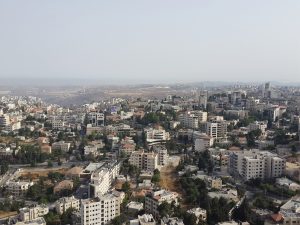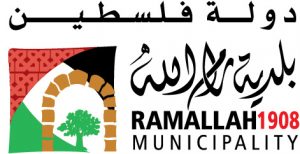Courtesy of Ramallah Municipality
Perched in the center of historical Palestine at 880 meters above sea level, Ramallah is famous for the gentle summer breeze that runs through its hills to bring respite from treacherous heat waves. Located 16 kilometers north of Jerusalem, Ramallah is cradled between its twin sister cities, Al-Bireh in the east and Betonia in the west.
Rama, an Aramaic word that means “a high hill,” combined with Allah signifies God’s High Hill, and it must be God’s gentle hands that send those wafts of coolness on hot summer nights.
Rashid Haddadin, of the Christian Haddadin family from Karak and Shobak in Jordan, founded modern Ramallah in the sixteenth century. He arrived in the area only to fall in love with its bountiful hills and generous roaring springs. Today, native Ramallah families carry the names of Haddadin’s sons. The famous lion statues in Al-Manara Square honor the city’s founders and the main families who originated from them.
In 1908 Ramallah’s municipality was founded, and a small village turned into a city that would continue to grow and evolve till today. In 1923, Al-Manara Square (then known as Al-Manara Circle) was built in the city center and became one of the city’s first landmarks. This is the figurative and literal heart of Ramallah where major religious, cultural, and political events take place. It is the point of origin for the main Ramallah roads that branch in several directions. Al-Manara has stood witness to the city’s growth, to the Israeli occupation, to the first and second intifadas. It has mourned and celebrated with its city residents. Al-Manara is where the Holy Fire is received from Jerusalem during the Holy Saturday celebrations that precede Easter, and where Christmas lights illuminate the streets and Ramadan decorations usher in the holy month.

Ramallah has always been a vacation destination for Arab and international tourists. In the past, visitors stayed in the Odeh Hotel, Qasr al-Hamra, or the Harb Hotel. Today visitors have a variety of hotel options, a thriving nightlife to enjoy, multiple cultural events to attend, and a diverse restaurant scene to try.
Ramallah is no stranger to occupation violence and pain, yet she rises every morning to face the new day with vitality fit only for the young and the hopeful. She has witnessed her fair share of repeated Israeli incursions. She has endured the Israeli army’s brutal siege of Palestinian leader Yasser Arafat’s headquarters. She is a city of resilience and a city of resistance. Ramallah knows only too well the brutality of Israeli occupation.
Ramallah’s architecture is a mixture of historical buildings and contemporary edifices that symbolize creativity and urbanity. The old city’s history artfully collides with the city’s contemporary spirit in an infinite kaleidoscope of humanity. Ramallah lives only to resonate the words of Mahmoud Darwish.
Ramallah beats to the rhythm of an urban center with the interconnectedness of a small town. She wakes up every morning to live again, to thank the heavens for another day to resist, to exist.


